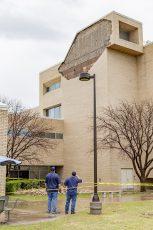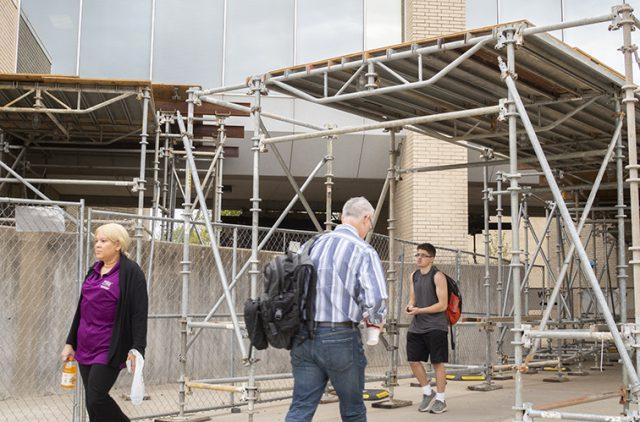| October 30, 2019 | Juan Ibarra | editor-in-chief |
|---|
In December 2016, an engineer’s report detailed concerns to the college about the aging facades on several NW Campus buildings, saying that they could possibly lead to “catastrophic failure.”
The report, from engineering firm Huitt-Zollars titled the Northwest Campus Facade Assessment, has never been publicly released, and TCC officials haven’t revealed many of the specific details in the assessment to the public. The Collegian obtained it through an open records request.
Linked below is the Huitt-Zollars facade assessment obtained through an open records request:
The NW Campus Facade Assessment
Reginald Gates, vice chancellor for communications and external affairs, did not respond to requests seeking comment.

Findings show that while the buildings are structurally sound, the 40-plus-year-old brick facades have issues such as missing brick ties, rust on studs and tracks, and mold in several areas.
A storm with high winds in the spring of 2016 tore off a large section of bricks from the WTLO building. No injuries were reported then, and no one has been hurt since then after scaffolding was put in place to protect students. But the assessment showed the risk of bricks falling from the facade still existed as of the time of the report.
“A failure may not happen tomorrow, but there is no guarantee that it will not, which adds to the urgency of addressing these concerns,” according to the report.
Every building on campus was found to have facade issues, and none of the buildings met the requirements of the International Energy Conservation Codes due to the original design and construction. NW Campus originally was constructed in 1974 with other buildings added through 1992.
Although some buildings did not meet modern standards, the construction appears to have followed common practices at the time, according to the assessment.
Yet one building had an unforeseen problem. The original construction documents for WTLO indicated that brick ties were to be used to keep the bricks attached to the walls. However, when Huitt-Zollars’ engineers investigated the area where the bricks had fallen, no brick ties appeared to be present at the WTLO tower.
“The lack of brick ties, age and possible unusually severe wind event all likely had some contribution to the failure but to what degree each contributed or if some other factor contributed is not clear,” engineer Dave Kiel said in the field observation report.
With the exception of three buildings, it was recommended by Huitt-Zollars that all buildings remove the brick and replace it with a new facade to ensure safety and remain within code.

After The Storm
The storm on March 8, 2016 removed 200 square feet of bricks from the side of the fifth floor of WTLO and started what would become a multi-year saga of scaffolding, fencing and evaluations.
In May 2016, TCC spent $192,197 to hire Huitt-Zollars to evaluate the damage and investigate whether it would happen again.
The evaluation ended in December of that year with the facade assessment being given to TCC and led to a series of reports and recommendations from Huitt-Zollars, ultimately telling TCC to make some drastic changes to stay up to code and to ensure the safety of the students and faculty on NW.
Then in January 2017, shortly after receiving the assessment, TCC spent $463,609 to install scaffolding across NW, which was later renewed for another 12 months in November for $356,257, and again for a third year in December 2018 at the price of $306,509.
While the scaffolding kept getting renewed, $240,394 was spent on architecture firm Huckabee and Associates, Inc. and design firm Gensler — both hired for redevelopment design services.
None of those expenses included the $220,884 spent in May 2016 to repair the initial damage.
All told, at least $1.7 million was spent between May 2016 and December 2017 to maintain the quality of the campus.

Inside The Assessment
According to the report, moisture was present between the structure and the brick facade.
And while two-inch air gaps are recommended to make sure moisture stays out of the walls, some of the air gaps found measured less than one inch.
Although some areas were missing brick supports, corrugated steel anchors were found within some walls.
However, at the time of the assessment, corrugated steel anchors were not allowed by code for any structures supported by steel studs, such as the WTLO building on NW.
All of the stair tower elements also showed signs of brick distress with exterior brick stair-step cracking, deteriorated bricks and uneven surfaces shown along several of the walls.
Stair-step cracking and separation of the brick and mortar led to “a lack of expansion and control joints” for maintaining stress and movement.
Even at WACB, a later addition to the campus, stair-step cracking and distressed bricks were found.
 In WHPE, the spacing, patterns and locations of brick ties and ladders were found to be inconsistent with modern-day standards.
In WHPE, the spacing, patterns and locations of brick ties and ladders were found to be inconsistent with modern-day standards.
“The exterior walls of the swimming pool at the roof level had severe mortar cracking at the brick ladders due to the expansion of the ladders from rust,” engineer Dustin Chappell said in the report about WHPE.
In a few locations on WACB, WSTU, WTLO and WCTS, engineers searched for brick ties and while they saw some there, a couple of areas either had no ties or had ones that were rusted.
Multiple facades needed further detailed investigations, and the engineers at Huitt-Zollars mentioned that a protection plan should be put in place for the safety of students, staff and faculty.
This final note led directly to the immediate installation of scaffolding and fencing “until such time as a detailed investigation can be completed and a conclusion can be made as to the condition of the facility regarding safety,” according to a TCC board memo.
Path to the Bond Election
Former board of trustees president Louise Appleman said recently that when she learned of the report, she was surprised to hear that the facades were not up to TCC’s usual standards.
“Did the guy building it not know any better, or was he just shortchanging us?” Appleman asked. “Had it not been for that freak-of-nature wind, we may have never known.”
As early as April 2017, the idea to renovate the campus was being thrown around according to former board member O.K. Carter.
“We were beginning to talk about the possibility of having to literally rebuild the campus,” Carter said.
The board knew the cost was going to be in the millions, and there seemed no recourse to recover that cost, according to Carter.
However, those plans appear to possibly have inspired the recent bond proposition as it outlines how TCC will use the money gained from a bond election for districtwide changes including renovations, construction and demolition on NW.
The bond proposition plan includes the demolition of WSTU, WTLO, WFAB and WADM as well as the construction of two new buildings along with updated classrooms and new parking lots.
If the bond is approved in the bond election on Nov. 5, the plans will be set in motion to renovate the campus, which would take at least until 2024.

Silence from the College
Since the report was given to the college in December 2016, TCC officials have spoken on the future of NW.
However, the college has yet to release many of the details or warnings in the assessment to the public.
In November 2017, nearly a year after the report was submitted to the college, vice chancellor for communications and external affairs Reginald Gates, when asked about the damage assessed on NW, told The Collegian, “We won’t know the extent of the improvements until a complete evaluation is finalized.”
The board of trustees authorized the installation of scaffolding as a precautionary measure while a more detailed evaluation could be completed, according to Gates.
When asked in December 2018 about plans for NW developments, Gates said, “The master plan includes new construction, renovation, demolition and site improvements.”
In May 2018, Gates spoke about the development of a new plan for NW.
“This work will take time, as the design and ultimately construction will take several years to complete,” he said.
Gates cited the importance of the scaffolding but gave no information as to why it was so necessary beyond the safety of the students and faculty.
“The scaffolding is to ensure everyone’s safety as repair and renovation work continues on the campus,” Gates said.
Nearly three years later, the scaffolding and fencing are still up.

